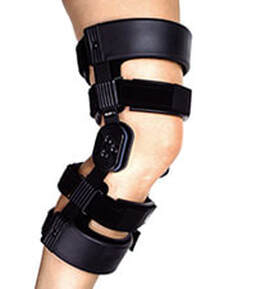Cleaning Your BracesOur cleaning video will help you care for your orthotic device. To jump to your specific brace, please go to the following timestamps:
00:35 - Foot Orthotics: Clean when dirty or have a pungent odour 02:06 - Knee Brace: Clean once weekly 03:41 - Spinal Brace: Clean once a week 05:14 - Dynamic Chest Compressor: Every two weeks 06:20 - Ankle Foot Orthotic: Once a month 09:38 - Boots and Bar: Once a week If you have questions, please give us a call at 905-527-1225 or email us.  While there’s no cure for knee osteoarthritis, a combination of strategies can help relieve your pain and keep you active. Although the cornerstones of treatment are exercise and physical therapy — and pain medications and steroid injections are also options — you can also try knee braces, shoe inserts or simply wearing more supportive shoes. “Knee braces can be helpful for managing your pain,” says physical therapist Dawn Lorring, PT, MPT. “The location and severity of your symptoms will drive which brace works best for you.” Osteoarthritis is caused by the breakdown of cartilage (that’s the cushioning material that covers the ends of bones in joints.) This causes pain and stiffness. In the knee joint, arthritis can occur at any of three points where the bones come in contact:
 Types of knee braces Sleeve braces. People who have mild pain or stiffness that limits their activities can try a sleeve-type brace. These provide compression, which can reduce swelling and warm the joint. This might relieve the stiffness. These braces also provide added support. “If your knee feels unsteady or wobbly, a compression-type brace can be helpful, Lorring says. Some of them have plastic stays or a hinge on the side, which provides a little more support. She recommends getting one that has an opening at the knee cap. Sleeve braces usually aren’t covered by insurance, but they are relatively inexpensive.  Unloader brace. When arthritic changes are between the femur and tibia, a device called an unloader knee brace may help, especially if one side is more arthritic than the other. These have a metal band that goes around the thigh and another one around the calf, connected by a hinged bar. This creates a frame that can be adjusted to shift pressure (unload) from one side of the knee to the other. “If the inside of your knee hurts, the brace can be adjusted to put more force on the outside of your knee, unloading weight off the inside,” Lorring explains. These are less beneficial if your arthritis symptoms are similar on both the inside and outside of the joint. Unloader knee braces are more expensive, but they can be covered by the Assistive Devices Program or private insurance. You’ll need a doctor’s prescription and documentation that it is medically necessary. Shoes and inserts. Various foot problems (like high arches or flat feet) or just the particular way you walk can affect the alignment of your body. That might be putting more pressure on your knee joints. You may get some relief by choosing better shoes or wearing shoe inserts (also called orthotics). Because everyone is different, there’s no universal advice for shoes or inserts. Lorring recommends consulting a physical therapist or an expert in foot mechanics who can observe how you walk and help you pick out shoes or shoe inserts that match your needs. “I encourage people to look at running shoes because there are more support options,” she says. “The goal with orthotics is to make sure your foot is moving in the best way it can so your knee isn’t getting more force than it should,” Lorring says. There are a wide variety of shoe inserts and heel wedges that you can buy in a drug store or online. You can also get them custom made or save some money and get semi-custom ones. Like with shoes, you need to get inserts and wedges that are specific to your needs. “You can have an insert that doesn’t add much arch support but it adds cushion, which can be beneficial if you walk on the outside of your foot,” Lorring says. “However, if your foot rolls inward too much, you may need more arch support.” You can get heel wedges that are sloped in one direction or the other, which is similar to the action of an unloader brace. It shifts pressure from one side of the knee to the other. “Ultimately, you have to find what works for you,” Lorring says. This article was based on one that originally appeared in Cleveland Clinic Arthritis Advisor. How Foot Orthotics Are Made
|
Welcome to our BlogCategories
All
Archives
April 2020
|
|
Advanced Orthodynamics
235 Locke Street South, Suite 1 Hamilton, ON L8P 4B8 905-527-1225 1-800-400-9203 [email protected] Ontario Assistive Devices Program Vendor |
|
Advanced Orthodynamics is a proud member of
Copyright @ 2024 advancedortho.ca

 RSS Feed
RSS Feed


